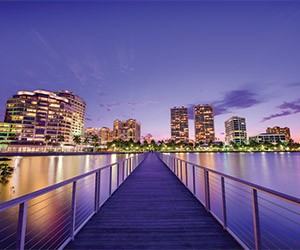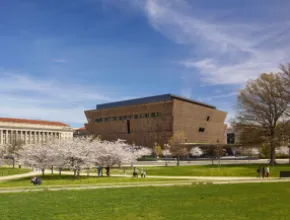With Florida’s reputation as a resort and theme park mecca firmly cemented, it might seem difficult to find the Florida that once was—a verdant land of cypress stands, upland hardwood forests, lush hammocks and the peninsula’s typical sandy scrub pinelands.
Underneath the tourism veneer, though, the Florida of old still lives, and you’ll find plenty of evidence at the parks and wilderness areas of Palm Beach County and the Treasure Coast, north of the bustling Miami/Fort Lauderdale urban corridor.
The green spaces of Palm Beach and the Treasure Coast—the latter composed of Martin, St. Lucie and Indian River counties—also make great group getaways as you can take attendees from the ballroom to the middle of nowhere in minutes, and hold events there, to boot.
“Meeting planners can pitch parks to their groups as something unique and off the beaten path, with something for everyone,” says Nicole Capp-Holbrook, tourism director of the Sebastian River Area Chamber of Commerce, which promotes such vast preserves as Pelican Island, designated as America’s first National Wildlife Refuge (NWR) by President Theodore Roosevelt in 1903.
Following are a few more choices in this neck of the woods.
Sebastian Inlet State Park
Diverse in ecology as well as activities, Sebastian Inlet State Park, set on the north end of Indian River County, is crossed by trails meandering through a coastal palm/oak hammock, while Atlantic beaches are the launch point for shelling, surfing, snorkeling and diving. Wildlife abounds. Not only is the park part of the Great Florida Birding and Wildlife Trail, but sea turtle sightings are frequent, especially in June and July when park rangers lead Turtle Walks & Talks.
Meanwhile, two on-site museums are open year-round—the Sebastian Fishing Museum, commemorating the area’s angling history, and the McLarty Treasure Museum, highlighting the ill-fated 1715 Spanish shipwreck that scattered gold and silver across the ocean floor, treasures that occasionally wash ashore and giving the Treasure Coast its glittering nickname.
There’s enough here to keep groups occupied for days, but if you want to throw group events into the mix, Sebastian Inlet offers four large pavilions that hold 80 people each as well as a private room atop the park restaurant, Inlet Grill.
“The view from that meeting room overlooks the Atlantic Ocean and Sebastian Inlet’s north jetty,” says Terry O’Toole, park services specialist. “You’re also overlooking the Bass Inlet and the Indian River. It’s a pretty, scenic spot.”
Savannas Preserve State Park
Extending more than 10 miles from Ft. Pierce to Jensen Beach in St. Lucie County, Savannas Preserve State Park is the largest and most intact remnant of Florida’s East coast savannas ecosystem. Multipurpose trails meander through the habitats of great horned owls and pine warblers as well as Florida scrub jays and majestic snowy egrets.
During the summer wet season, parts of the trail may be under water, so check beforehand. Staff at the education center can assist with guided walks and kayak trips, while the center itself hosts nonprofit and small groups. At press time, a new building with rental space for meetings was due to open pending internal approvals.
PageBreak
Spruce Bluff Preserve
Two self-guiding interpretive trails highlighting two very different settlements are waiting at 97-acre Spruce Bluff Preserve in Port St. Lucie. Follow one path to what’s left of the town cemetery—a small monument and some broken gravestones—the only thing remaining of an 1891 pioneer settlement whose fortunes were dashed when the harsh winter of 1894-95 killed most of the area’s pineapple and citrus.
The other trail leads to a prehistoric Ais Indian mound, about 20 feet tall and 180 feet in diameter, likely used for burial purposes. Along the way, visitors take in a landscape of scrubby flatwoods and wetlands.
Timer Powers Park
Located in Indiantown on the western fringes of Martin County, Timer Powers Park offers 37 scenic acres bordering the St. Lucie Canal and is part of the Lake Okeechobee Scenic Trail.
A new equestrian arena draws rodeo crowds, but the facility also is available for rentals when not in use. Other options at Timer Powers include a community center with an outdoor pavilion, which combine to create an indoor and outdoor event space.
“The biggest pavilion we have is in the middle of an open field; it can hold about a hundred,” says Leticia Farias, recreation leader for Martin County Parks and Recreation.
One local organization using the park? Martin County Parks and Recreation, which will hold its next annual strategic planning session there, says Kevin Abbate, the department’s director.
“It will be mostly outdoors. We’ll be sitting on the grass to talk; we won’t be sitting at tables in air conditioning,” Abbate says. “I think the best ideas flow when you’re outside in the fresh air.”
Indian RiverSide Park
Closer to civilization in Martin County, Indian RiverSide Park is on the beach side of the Indian River Lagoon—called the most biologically diverse estuary in North America—and boasts a walking path, fishing pier and beach while also being home to the U.S. Sailing Center of Martin County.
Also on-site is the stunning Mansion at Tuckahoe, listed on the National Register of Historic Places and available for meetings and events.
“You just walk out of the door of the mansion and you get these sweeping views of the Indian River Lagoon,” says Gabriella Ferraro, communications and outreach coordinator for the Martin County Board of County Commissioners.
DuPuis Management Area
Just east of Lake Okeechobee in northwestern Palm Beach County, the DuPuis Management Area covers 21,875 acres and includes numerous ponds, wet prairies, cypress domes, pine flatwoods and remnant Everglades marsh. Groups can explore it on 22 miles of hiking trails or take a 15-mile, self-guided auto tour. Fishing, canoeing/kayaking, wildlife viewing, group camping and an equestrian center are part of the fun.
“We’re very remote and the property is very primitive… it’s a little extra work, but it’s so worth it,” says Kim Elliott, education and training coordinator for the FAU Center for Environmental Studies, which is based at the DuPuis Nature Center, featuring an adjacent butterfly garden and nature trail through wetlands and a cypress forest.
John D. MacArthur Beach State Park
The only state park in Palm Beach County, John D. MacArthur Beach State Park sprawls across 438 acres between the Atlantic Ocean and Lake Worth Lagoon, creating four distinct natural communities—a maritime hammock, an estuary, beaches and dunes, and a limestone rock reef that, unlike reefs found in the Florida Keys, is visible from the shoreline and easily reached by snorkelers. Sheltered by these environments are 22 animal species designated as endangered or threatened.
Among the many activities here, besides snorkeling, are kayaking, nature walking, swimming and picnicking, with a welcome center on hand to offer interpretive exhibits and films explaining the park’s many features. The park also is home to an education center whose 50-person classroom is available for group and corporate rentals.





